24. Of drop and drift
You’re smart to think beyond the muzzle and consider the bullet not as a rocket but as a fragment driven yonder by an explosion. This mindless sliver of lead, spinning madly, must rip through powerful forces we know collectively as air. Air is not a void. It is like water. It offers resistance to penetration. If you dip your hand in water, you feel a little resistance but not much. When you swim, you feel much more resistance. A belly-flop from the 7-meter board shows you more resistance still. Bullets trace paths unique to themselves and subject to conditions. Looking through a high-power target scope as you launch a .22 match bullet downrange, you’ll see the trajectory as a hook, fore-shortened in the lens. Thinking of bullets as curve balls thrown by a pitcher can help you put them in the vitals of big game. It’s important that you know the range and shoot to that yardage. This may seem elementary. Still, many hunters make poor shots because they think in straight lines.
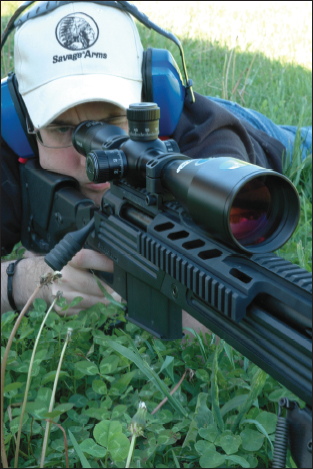
Bill Dermody shoots a Zeiss-scoped Savage tactical rifle in .338 Lapua, a favored sniper round.
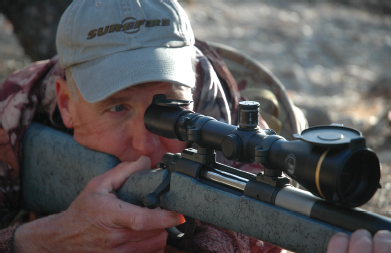
Wayne fires a Magnum Research rifle in 6.5 Creedmoor, designed for long reach with light recoil.
A BB is hardly more accurate than a stone from a slingshot. But long ago my Daisy lever-action hit small targets at ranges to 50 yards. The reason I shot it well was that I shot it so much. I learned how the steel pellets reacted to air and gravity. Their lazy arcs came to me in my sleep. Intuitively, it seemed, the coarse steel blade would find some corner of space above and to the side of what I wanted to hit, and in due time the BB would land there. BBs behaved much like the 25-cent arrows I launched from the fiberglass bow I bought with Green Stamps to harass local starlings. From these crude tools I learned that aiming is simply an attempt to arrange a collision at some point in space.
Seeing a bullet’s arc is a distinct advantage in learning about trajectory. That’s why machine guns and anti-aircraft cannons are fed tracer bullets at regular intervals. Drag, drift and deceleration all show up with great clarity in tracer paths. Gunners trained to shoot at Axis airplanes during World War II were often started with BB guns that made trajectory and flight time easy to comprehend.
As soon as a bullet leaves the muzzle of your rifle, it starts to drop at an accelerating rate of 32.16 feet per second. But bullets seldom stay aloft for an entire second. A 160-grain 7mm magnum bullet started at 3,150 fps will hit a deer 250 yards away in about a quarter of a second, given deceleration that brings average velocity to 3,000 fps. During that quarter-second the bullet drops 3 feet (not 8 feet, as gravity pulls it faster and farther the last quarter second than the first). If your line of sight were parallel and tangent to line of bore, the bullet would strike 3 feet low. A slower bullet drops the same distance during the same time. It just doesn’t cover as much ground in flight. Say your 165-grain .300 Savage bullet clocks an average 2,400 fps (800 yards per second) over its first 200 yards. After a quarter second it will pass that 200 yard mark. So instead of landing 3 feet low at 250 yards, as with the 7mm magnum, it prints 3 feet low at 200. Bullet speed doesn’t affect gravity; it simply determines the reach of the bullet’s parabolic arc.
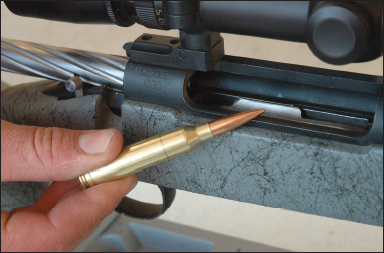
VLD bullets, as in this 7mm Remington Magnum round, reduce drop and drift distance.
Crude illustrations of trajectories show them as rainbows. As Galileo found, they are not. Because air is pushing against the bullet’s nose, sucking on its tail and clawing at its shank, the bullet slows down as soon as there’s no more thrust on its base. The slower it goes, the less ground it covers per unit of time. The arc gets steeper downrange. If you dropped a bullet from your fingers at the same time a bullet was fired horizontally from a rifle the same distance above the ground, the two bullets would come to earth at very nearly the same time. It’s true!
Cartridges like the .30-378 Weatherby excel at long range because the velocity that gives them the impact of a wrecking ball also flattens trajectory. A moose 450 yards away will escape your bullet if you’re shooting a .30-06 and underestimate the range as 350. A .30-378 bullet flies flatter and will still strike the vitals, albeit several inches low. Many shooters have been bamboozled into thinking a bullet rises above line of bore during its flight. It does not. The misunderstanding results from illustrations of trajectory that aren’t carefully drawn. Sight-line is not parallel to bore-line, but at a slight converging angle. Sight-line dips below bore-line and the bullet’s arc. Sight-line never meets bore-line again, because both are straight. They cross and forever get farther apart. A bullet will hit above sight-line at midrange, but only because sight-line angles down through its trajectory. Sighting in or zeroing a rifle is simply adjusting the sights so you are looking where the bullet hits. Zero range is not point-blank range. Shooting point-blank is shooting with no compensation for a bullet’s trajectory. Hunting big game, you can ignore small differences between point of aim and point of impact. If you can abide a 2-½ inch deviation, a 200-yard zero will give your .30-06 a point-blank range of 230 yards or so, depending on the load. Maximum point-blank range is the distance at which a bullet falls so far below line of sight that you must compensate for gravity’s pull by raising your point of aim.
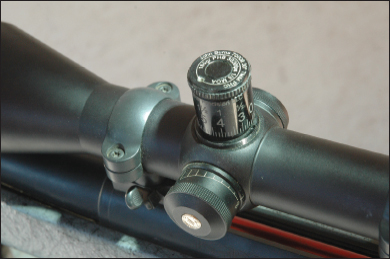
This Leupold scope has a parallax dial, plus a GreyBull elevation knob for a 7mm magnum load.
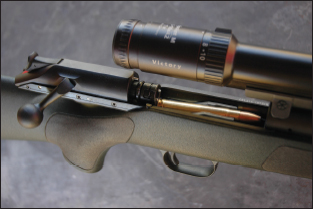
The straight-pull Blaser R93, here in .375 H&H, is beautifully engineered, lightning-fast to cycle.
Another force that moves your bullet from sight-line is wind. Wind is like gravity on a horizontal plane. As the bullet slows, a constant wind has greater effect. But, unlike gravity, wind force and direction are not constant. In competition, I’ve often fired through wind that straightened the target flags one way while swinging mechanical wind vanes the opposite direction on the line. While wind at the muzzle has more effect on impact point than does an equivalent shift downrange, the bullet is more easily moved the farther it gets from the muzzle because downrange there’s more time per unit of distance traveled for the wind to work its mayhem. A slight pick-up or let-off or fish-tail can flip your bullet wild after you press the last ounce from that trigger. A “full value” or 3 to 9 o’clock wind has the greatest effect on strike point.
You’ll get a good start as a wind-doper with a ballistics program from Ken Oehler or the people at Sierra Bullets, or Nikon computer program that shows wind deflection for popular loads. Punch in the velocity and ballistic coefficient of your bullet, and Oehler’s Ballistic Explorer will plot a bullet track, telling you about energy, point-blank range and wind drift beside showing bullet drop. The Sierra program is fully as useful. There’s even a way to calculate ballistic coefficient from simple flight data you collect at the range.
Air temperature also affects bullet behavior. Warm air is thinner than cold air, so your bullet meets less resistance on a warm day, just as an airplane gets less lift on a warm day. Honestly, you won’t see much difference in bullet impact due to the effect of air temperature on bullet flight. Figure no more than half a minute of elevation for every 100 degrees change in temperature. But trajectory is also affected by breech pressure: the higher the pressure, the faster the bullet. A hot day can raise the temperature of the powder, generating higher pressure. A cold day can make the cartridge perform sluggishly. Tests run by Art Alphin (A-Square) with a .30-06 showed that at 40 degrees a charge of 51 grains RL-15 generated 54,600 PSI to push a 180-grain Nosler Ballistic Tip at 2,675 fps. The same rifle and load registered 59,900 PSI and 2,739 fps when the temperature was 120 degrees. The temperature of the ammunition is what’s important. A cartridge kept in a warm pocket and fired soon after loading in a rifle on a cold morning will perform as if the chamber temperature were warmer than the ambient temperature. Cartridges left on a hot dashboard in a safari vehicle can get much warmer than the rifle and cause higher pressures than ambient temperature would indicate. The effect of changes in temperature on ammunition varies with the load. Some powders are more sensitive than others, and if you’re approaching the safe pressure limit, you may get a dangerous spike in pressure with a relatively modest increase in temperature. Rule of thumb: Figure a velocity change of 3 fps for every degree of temperature change.

This bear roamed open tundra, where bullet drop matters. A flat-flying Swift Scirocco from Wayne’s .300 Remington Ultra Mag landed on target.

This .243 load shoots flat and accurately from Wayne’s Howa rifle—a good choice for pronghorns. But a heavier bullet would reduce drift in windy conditions, and suit the round for bigger game.
As you’d expect, altitude also influences bullet flight. The higher you go, the thinner the air and the less resistance it offers. The effect is greatest with flat-nose bullets. According to T.D. Smith, a former fighter pilot who has used his military experience to develop long-range shooting aids for small arms, a .30-30 bullet hits about 9 inches higher at 300 yards when fired at 10,000 feet than when fired at sea level. In contrast, a ballistically more efficient 175-grain bullet from a 7mm Remington Magnum strikes less than 3 inches higher in the thinner air. The longer the range, the greater the difference in point of impact due to changes in air resistance. Hunters, however, know that as you climb into thinner air, temperatures typically drop. So elevation and air temperature changes can cancel each other out. In the mountains, air resistance can be greater (because of the cold) and less (because of the elevation) than its resistance at sea level. On a hunt, I ignore these variables.
Another thing to ignore is the Coriolis effect. The earth’s rotation causes a bullet to drift slightly right in the northern hemisphere, slightly left in the southern hemisphere. Get on a merry-go-round moving clockwise and toss a ball to someone else on the merry-go-round. The ball seems to curve left. It doesn’t; only your frame of reference imposes that illusion. Coriolis acceleration for any bullet can be described by this mathematical equation: Y=2wVsin(latitude), where w is the earth’s rate of rotation (.0000729 degrees per second) and V is average bullet speed in feet per second. For a bullet traveling 2,800 fps at a latitude of 45 degrees north, Coriolis acceleration comes out to .30 fps/second, or roughly 1 percent of the acceleration of gravity. At 350 yards, you’ll get half an inch of displacement. That’s not enough to notice, because your hunting rifle probably won’t shoot 1 inch groups at 350 yards. At long range, the Coriolis effect can be significant. Air Force F-16 fighter cannons are not wired for Coriolis correction, says T.D. Smith. “But the on-board computer is programmed for a 6 inch correction at 5,000 yards with the Mark 82 or Mark 84 dive bomb.” Longer bombing ranges require a higher correction value. Here’s a rule of thumb for hitting distant targets with a sporting rifle: Figure a 1 inch Coriolis correction for each second of bullet flight time.
A rotating bullet generates other forces that cause drift. One of these is gyroscopic effect, which amounts to twice the Coriolis drift—and is thus negligible in most hunting situations. Spun by a right-twist bore, a bullet moves slightly right. Left-twist rifling pushes bullets left. The reason: Torque within the bullet throws its nose slightly in the direction of spin. There’s a vertical component to gyroscopic effect too, albeit you’ll need a very accurate rifle to see it. The right-hand twist in my Remington 37 smallbore match rifle sends bullets to 4 o’clock in wind from the left, to 10 o’clock in wind from the right.
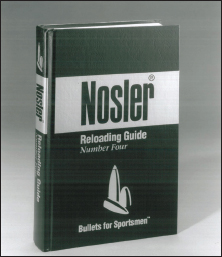
Nosler and most other bullet-makers publish comprehensive manuals. Their load data makes them a must for handloaders— and anyone interested in ballistics.
Table of contents
- Title Page
- Dedication
- Copyright
- Acknowledgments
- Foreword
- CONTENTS
- INTRODUCTION
- SECTION I: BALLISTICS IN HISTORY
- SECTION II: THE MUSCLE BEHIND THE SHOT
- SECTION III: BULLETS—THE INSIDE STORY
- SECTION IV: SPEED, ENERGY, AND ARC
- SECTION V : PUTTING BALLISTICS TO WORK
- SECTION VI: FOR LONGER REACH
- BALLISTICS TABLES FOR MODERN SPORTING RIFLES
- GLOSSARY